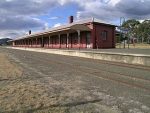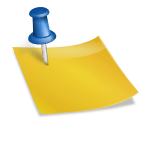Today we are announcing a new challenge for our readers – Guess the Artefact! We post pictures of an artefact and you can guess what it is. The text will slowly reveal the answer, through a process of examination and deduction – see if you can guess what it is, before the end. We are starting this challenge with an item from our year 6 Archaeological Dig workshop. Year 6 (unit 6.3) students concentrate on Federation in their Australian History segment – so that’s your first clue! Study the image and then start reading the text below.

Our first question is what is it? Study the image and see if you can work out what it might be – it’s an dirty, damaged piece of paper. It seems to be old. Does it have a date? Ah yes, there are 3 dates – 23, 24 and 25 October, 1889, so we deduce that it must be old, dating to the end of the 19th century. We will file the exact date for later consideration. We also note references to railways. The layout of the information suggests a train ticket. So we have a late 19th century train ticket!
Now why do we have this train ticket and whose train ticket might it have been? The ticket is First Class, so this is someone who could afford to travel in style. Where were they going? The railways mentioned are Queensland Railways, Great Northern Railway, New South Wales Railways and the stops are Brisbane, Wallangara, Tenterfield and Sydney. Now we need to do some research. Queensland Railways and New South Wales Railways seem self-evident, but what is Great Northern Railway? A brief hunt reveals several possible candidates: 1) a contemporary rail operator in Victoria; 2) a line in Queensland connecting Mt Isa and Townsville and 3) an old, now unused railway in New South Wales. We can reject option 1) immediately. Option 2) is the right state, but the towns seem unrelated. That leaves option 3), which seems most likely. Looking into the NSW option in more detail we note that it ran between Sydney and Brisbane, with a stop at Wallangara to change gauge – Bingo!

More research reveals that the line reached Wallangara in 1888, the year before this ticket was issued. Only after 1888 was it possible to travel from Brisbane to Sydney by rail, albeit with a compulsory stop at Wallangara. We note also that the ticket contains a meal voucher for dinner at the Railway Refreshment Rooms in Wallangara. Presumably passengers overnighted in Wallangara before continuing on to Sydney on a different train and rail gauge. Checking the dates on the ticket, we can see evidence of an overnight stop, as the next leg continues from Wallangara on the next day (24 Oct 1889). However, next we come to some important information. From Wallangara, the next leg of the journey represented by this ticket was only as far as Tenterfield. Looking on a map, we note that Tenterfield is only about 25 km away – hardly a day’s train ride, more like an hour or two at the most (steam trains averaged about 24 km/hr at the time). From this we deduce that the ticket holder wanted to stop at Tenterfield and continue their journey on the next day.
 We know that we’re studying Australian Federation history, so the name Tenterfield should start to a ring a bell – what happened in Tenterfield in 1889 that was relevant to Australian Federation history? The answer, of course, is that Henry Parkes delivered his Tenterfield Oration there, and the date? 24 October, 1889! If we look into the background, we quickly discover that Henry Parkes was on his way from Brisbane back to Sydney, when he stopped in Tenterfield. He had been seeking support for Federation from the government of the colony of Queensland. He broke his journey in Tenterfield, a town representative of those towns closer to the capital of another colony than their own, which would benefit from the free trade arrangements flowing from Federation. Parkes even discussed the issue of different rail gauges as something that would be solved by Federation! We can therefore surmise that this ticket may well be the ticket of Henry Parkes, documenting his journey from Brisbane to Sydney in October, 1889, during which he stopped and delivered the Tenterfield Oration!
We know that we’re studying Australian Federation history, so the name Tenterfield should start to a ring a bell – what happened in Tenterfield in 1889 that was relevant to Australian Federation history? The answer, of course, is that Henry Parkes delivered his Tenterfield Oration there, and the date? 24 October, 1889! If we look into the background, we quickly discover that Henry Parkes was on his way from Brisbane back to Sydney, when he stopped in Tenterfield. He had been seeking support for Federation from the government of the colony of Queensland. He broke his journey in Tenterfield, a town representative of those towns closer to the capital of another colony than their own, which would benefit from the free trade arrangements flowing from Federation. Parkes even discussed the issue of different rail gauges as something that would be solved by Federation! We can therefore surmise that this ticket may well be the ticket of Henry Parkes, documenting his journey from Brisbane to Sydney in October, 1889, during which he stopped and delivered the Tenterfield Oration!
This artefact is therefore relevant as a source for anyone studying Federation history – as well as giving us a more personal insight into the travels of Henry Parkes in 1889, it allows us to consider aspects of life at the time:
- the building of railway connections across Australia, in a time before motor cars were in regular use;
- the issue of different size railway gauges in the different colonies and what practical challenges that posed for a long distance rail network;
- the ways in which people travelled and the speed with which they could cross large distances;
- what rail connections would have meant for small, rural towns, to mention just a few.
- Why might the railway companies have provided meal vouchers?
These are all sidelines of inquiry, which students may be interested to pursue, and which might help them to engage with the subject matter in more detail.
In our Archaeological Dig Workshops, we not only engage students in the processes and physical activities of the dig, but we provide opportunities for them to use the artefacts to practise deduction, reasoning and research – true inquiry-based learning, imitating real-world processes and far more engaging and empowering than more traditional bookwork.


The program reduces my planning time as I only have to plan and research for one integrated unit.
Trent Perry, Teacher